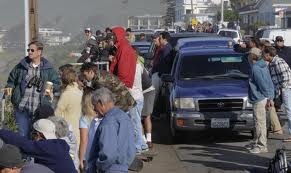题目内容
Tsunami warning system is tested
If he, the founder of the Hawaiian Volcano Observatory, were alive, Thomas Jaggar would be proud of the U.S. tsunami warning system after Friday’s devastating earthquake in Japan sent a surge (大浪,汹涌) of ocean water dashing toward the West Coast.
● WASHINGTON — So many people surged to the West Coast and Alaska Tsunami Warning Center website that it slowed to a crawl early Friday, unable to provide critical information to the public about the coastal impact in the U.S. of a massive earthquake in Japan.
McClatchy Washington Bureau — Mar 11 06:09 p.m.
● CHICAGO — A tsunami warning has been issued for the central and northern California coast and Oregon, the National Weather Service announced early Friday.
Chicago Tribune— Mar 11 06:07 a.m.
● HONOLULU — A tsunami warning was issued late on Thursday for Hawaii after an 8.9 magnitude earthquake struck in the Pacific near Japan, prompting state civil defense officials to order all coastal areas evacuated(把…撤出…)by 2 a.m. local time. Tsunami sirens (警报) began sounding at 9:59 p.m. on Thursday. They have sounded every hour since 11:15 p.m.
Alaska Tsunami Warning Center also issued a warning for much of the coasts of Alaska, Washington, Oregon and California.
Reuters via Yahoo! News — Mar 11 01:22 a.m.
● LOMPOC — Tsunami warning ‘a wake-up call’
A tsunami warning that led to evacuations for coastal 
communities and campgrounds in Santa Barbara and San Luis Obispo counties Friday served as a successful trial for a more serious emergency, officials said after the danger passed.
The Lompoc Record — Mar 11 11:29 p.m.
● WELLINGTON — The Pacific Tsunami Warning Centre issued a warning after an 8.9 magnitude earthquake struck in the Pacific near Japan, and it said the sea level readings confirm that a tsunami has been generated and was in effect for some Pacific islands — Hawaii, China’s Taiwan, the Philippines and Indonesia etc.
New Straits Times — Mar 11 07:48 a.m.
— Reproduced by Yahoo Greenwich Meantime
【小题1】.
. A tsunami warning was issued for all the following states in the U.S. except for _____.
| A.Ohio | B.California | C.Oregon | D.Alaska |
The underlined word “prompting” (in the fourth paragraph) most probably means _____.
| A.promoting | B.advocating | C.urging | D.appealing |
According to the passage, the Pacific Tsunami warning was first reported by _____.
| A.New Straits Times | B.Reuters via Yahoo! News |
| C.McClatchy Washington Bureau | D.Chicago Tribune |
In which city did the news agency issue a tsunami affecting for some other places apart from Japan and Hawaii?
A. LOMPOC. B. WASHINGTON. C. HONOLULU. D. WELLINGTON.
【小题1】A
【小题1】C
【小题1】B
【小题1】D
解析

 一本好题口算题卡系列答案
一本好题口算题卡系列答案The Haitian tsunami gave scientists a chance to find out how well vital and potentially life-saving warning systems were working.
Noaa’s Pacific Marine Environmental Laboratory has developed a warning system that picks up signals of tsunamis directly from the sea-floor.
It is called Dart-the Deep-ocean Assessment and Reporting of Tsunamis. If seismometers(地震仪) detect an earthquake, the Dart buoys(浮标) will determine what is happening to sea levels, and whether a big wave might be on the way. This information is then sent via satellite to a central location which can organize an alarm. Within 50 minutes of the Haiti earthquake, this system was able to issue an alarm to other countries in the Caribbean to say that a small tsunami had been caused to start, and that was unlikely to affect them.
Dr Bernard said, “The first 30 minutes following the earthquake, we have to rely on education.” The critical aspects of this are: do you feel the earthquake; do you see the ocean draw down; and do you hear that loud roar? If so, you should run for higher ground.
“But after the first few minutes, it’s crucial that we have the technology—the measurements to avoid unnecessary evacuation(疏散撤离)and tell people when it is safe to return.” Right now, there are 50 of these Dart buoys all over the globe—four of which are in the Caribbean.
Dr Bernard says that, with 75 to 100 buoys worldwide, this system could provide global tsunami warnings within one hour.
“That’s for everywhere we know that tsunamis have happened. If we wanted to go to half an hour detection, we could probably double or multiply by four times that number,” he said.
“In some countries, including Haiti, there may not be enough resources to support a specific tsunami warning centre for something that happens so infrequently.”
He said that this system was relatively inexpensive to fix and operate.
“To get it down to an hour for everywhere affected would cost $50m initial investment and then 10% of that to maintain it,” he said.
“That’s not a terribly expensive system considering the potential savings of lives.”
【小题1】In which section would you probably read the passage in a newspaper?
| A.Education and Society |
| B.Culture and Leisure |
| C.Science and Technology |
| D.Health and Medicine |
| A.150 |
| B.100 |
| C.75 |
| D.50 |
| A.The system can warn people of the coming of tsunami directly after the earthquake. |
| B.We can’t escape the danger of tsunami within 30 minutes following the earthquake. |
| C.Each country can easily afford a tsunami warning centre though it seldom happens. |
| D.It’s worthwhile to spend money on the warning system for possible savings of lives. |
| A.Tsunami Assessment |
| B.Earthquake detecting |
| C.Disaster Warning System |
| D.Life Saving System |
For hundreds of years, Japan has been hit, from time to time, by tsunamis(海啸), which are caused by earthquakes or underwater volcanoes. The story of the boy Yuuki is the story of such a disaster.
Yuuki lived with his family in a seaside village, below a small mountain. One day, as he played on top of the mountain, Yuuki felt a small earthquake but it was not strong enough to frighten anybody. Soon after, however, Yuuki noticed the sea darken and begin running away from the shore very fast, leaving behind wide areas of beach that had never been seen before.
Yuuki remembered reading that just before a terrible tsunami, the sea suddenly and quickly rolls backward. He ran to the beach, warning the villagers who had gathered to admire the new beach land.
But no one listened. They laughed at him and continued playing in the new sand.
Desperate, Yuuki could think of only one thing to do. He lit a tree branch, raced to the rice fields and began burning the harvested rice. Then he called out, “Fire! Fire! Everyone run to the mountain! Now!”
When everyone reached the mountain top, a villager cried out, “Yuuki is mad! I saw him set the fire.” Yuuki hung his head in shame, but said nothing as the villagers screamed at him.
Just then, someone shouted, “Look!”
In the distance a huge dark wave of water was speeding towards the shore. When it hit the shore, it destroyed everything.
On the mountain everyone stared at the village ruins in terror.
“I'm sorry I burned the fields,” said Yuuki, his voice trembling.
“Yuuki,” the village chief answered. “You saved us all.”
The villagers cheered and raised Yuuki into the air. “We were going to celebrate our rice harvest tonight,” said one, “but now we’ll celebrate that we’re all still alive!”
1. Where was Yuuki when the earthquake struck?
|
A.On the beach. |
B.On the mountain. |
|
C.In the rice fields. |
D.At home. |
2.In what order did the following events take place?
a.Yuuki ran to the rice fields.
b.The villagers paid no attention to Yuuki’s word.
c.Yuuki went to warn the villagers.
d.The village was in ruins.
e.The people were screaming at Yuuki.
|
A.c, b, d, a, e |
B.a, c, d, b, e |
C.c, b, a, e, d |
D.a, c, d, e, b |
3.How did Yuuki save the villagers from the disaster?
|
A.He told them about the earthquake. |
|
B.He explained why the sea was flowing out. |
|
C.He told the village chief to warn the people. |
|
D.He set fire to the rice field. |
4.What were the people planning to do before the tsunami struck their village?
|
A.Burn the rice crop. |
B.Play on the beach. |
|
C.Climb the mountain. |
D.Celebrate the rice harvest. |